spectrometer | For analyzing light intensity
- Details
- Hits: 8210
In our current article we look at the latest ones spectrometer Developments and trends as well as their growing importance in industry and Research. Find out how modern spectrometers analyze the spectrum and wavelengths of light more precisely than ever before, contributing to innovative applications in various specialist areas.

Contents
- Spectrometer 2024 – The most important things in brief
- Spectrometer innovations
- NIR spectrometer controls quality of olive oil
- Spectrometer with outstanding ED-XRF analysis
- Ultra-high field spectrometer for cutting-edge research inaugurated
- Spectrophotometer for highly accurate color measurement
- FT-IR spectrometer with touch panel – video
- Spectrometer measures irregularities in solar activity
- FAQ
Spectrometer 2024 – The most important things in brief
Spectrometers serve researchers and developers as indispensable measuring instruments in the scientific analysis. They offer increasingly precise insights into the composition of materials through to the latest findings in human cell research.
The Trends in spectrometry are characterized by advanced detection techniques and the integration of AI for data evaluations. Spectrometers play a crucial role in the research of new materials, in environmental analysis and in medical diagnostics. Their ability to analyze complex spectra makes them indispensable for groundbreaking research in areas such as nanotechnology, pharmaceuticals and biotechnology. These tools provide valuable data essential for understanding molecular interactions and developing new therapies and technologies.
In the industrial Quality Assurance In addition to material testing, spectrometers are used for contamination testing Food industry, colorimetry in textile and coating control, for emission control of industrial plants or for petrochemical analysis of e.g. B. petroleum products.
Spectrometer innovations
Below we present to you new products and application examples from industry and research:
NIR spectrometer controls quality of olive oil
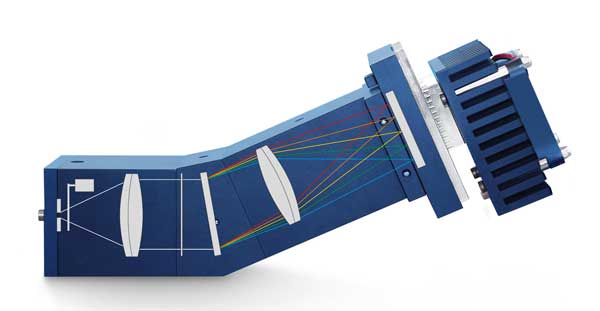 Feb 07.02.2024, XNUMX | Legal requirements force food producers to carry out strict quality controls. This is intended to protect consumers from harmful substances and to clearly declare ingredients. Near infrared- (NIR) spectrometers are the right tool for this. They allow reliable and non-destructive measurements of a wide variety of ingredients directly in the production lines of e.g. B. dairy products and baked goods, meat products, confectionery or cooking oils.
Feb 07.02.2024, XNUMX | Legal requirements force food producers to carry out strict quality controls. This is intended to protect consumers from harmful substances and to clearly declare ingredients. Near infrared- (NIR) spectrometers are the right tool for this. They allow reliable and non-destructive measurements of a wide variety of ingredients directly in the production lines of e.g. B. dairy products and baked goods, meat products, confectionery or cooking oils.
Near-infrared spectroscopy works with light between approx. 800 and 2500 nm wavelength. When absorbing NIR radiation Molecules to vibrations stimulated. Information about the molecular composition can be read from the reflected spectra. These can then be used to identify and quantify substances. The following application makes this clear:
Determine oil content before pressing
Polytec has spectrometers in its portfolio with a modular design that can be flexibly adapted to the given product or process properties. NIR spectrometers are used in many areas of food production: manufacturers of cooking oils use the technology to determine the oil content of oilseeds and fruits before pressing. For olives, oil and acidity can be determined directly after harvesting on the conveyor belt. This is important because suppliers are paid based on the oil content of the olives.
Fatty acid content determines the quality level
After the first pressing, an NIR spectrometer measures the fatty acid content, which determines the quality class. For example, with the highest quality class extra virgin the fatty acid content should not be more than 0,8, or even better, less than 0,5%. The residual oil content of the pomace can be determined after pressing in order to decide whether further processing with a lower quality class is worthwhile. NIR spectrometers can help to increase the efficiency of the pressing process and ensure and, ideally, increase the quality of the cooking oil produced.
Spectrometer with outstanding ED-XRF analysis
 25.01.2024 | SpectroAnalytical Instruments presents the latest generation of the spectrometer “Spectro Xepos” as a further quantum leap in energy-dispersive X-ray fluorescence analysis (ED-XRF). It is designed to outperform traditional ED-XRF instruments with performance often equal to that of wavelength-dispersive WD-XRF instruments - at significantly lower operating costs.
25.01.2024 | SpectroAnalytical Instruments presents the latest generation of the spectrometer “Spectro Xepos” as a further quantum leap in energy-dispersive X-ray fluorescence analysis (ED-XRF). It is designed to outperform traditional ED-XRF instruments with performance often equal to that of wavelength-dispersive WD-XRF instruments - at significantly lower operating costs.
The latest Spectro Xepos features numerous improvements including:
- improved Spectral deconvolution for higher accuracy of the screening methods even with difficult samples with a complex spectrum.
- Up to 2x shorter measuring times than the previous model, but with comparable precision. For many samples, complete analysis is completed within 1 to 2 min.
- New Multilayer package allows the spectrometer to analyze the thickness down to the nanometer range and the composition of up to 8 layers for up to 55 elements on a substrate. As a result, the device delivers reference-free analysis that is based solely on solid, pure samples.
The new spectrometer is particularly suitable for demanding tasks for quick overview analyzes or precise quality control. Applications can be found in environmental technology, petrochemistry and chemistry, geology, the food and feed industry, and pharmaceuticals, among others.
Four model variants offer optimized performance for the relevant element groups in the corresponding matrices.
Ultra-high field spectrometer for cutting-edge research inaugurated
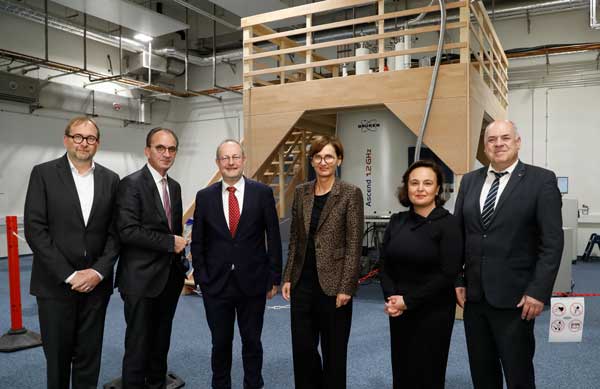 01.12.2023 | At the Goethe University A state-of-the-art nuclear magnetic resonance spectrometer (NMR spectrometer) with a frequency of 1,2 gigahertz was put into operation in Frankfurt, a milestone in biomolecular research.
01.12.2023 | At the Goethe University A state-of-the-art nuclear magnetic resonance spectrometer (NMR spectrometer) with a frequency of 1,2 gigahertz was put into operation in Frankfurt, a milestone in biomolecular research.
Personalities such as the Federal Research Minister were at the inauguration Bettina Stark Watzinger and Hesse's finance minister Michael Boddenberg present. The spectrometer, an investment of 30 million euros financed by federal funds, the state of Hesse and the university, is one of the most powerful of its kind in the world and specializes in the study of biomolecules in vaccine, cancer and Alzheimer's research.
This cutting-edge device opens up new possibilities in researching the spatial shape of biomolecules, particularly “intrinsically disordered proteins”. These proteins, which make up more than a third of the proteins in human cells, are crucial for the functioning and control of proteins in the cell.
Deviations in these proteins can lead to neurodegenerative diseases such as Alzheimer's, cancer and cardiovascular disease. Equipped with innovative superconducting technology, the NMR spectrometer generates an extremely homogeneous magnetic field that is 600.000 times stronger than the earth's magnetic field and thus enables precise investigations.
Spectrophotometer for highly accurate color measurement
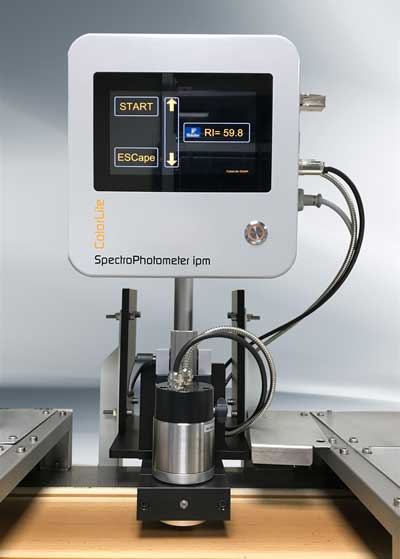 March 25.03.2020, XNUMX | To ensure a lower scrap rate in production, the processes must be constantly monitored. ColorLite has developed the spectrophotometer SPH IPM for 100% color measurement. Thanks to the high measurement stability and accuracy, complex laboratory analyzes are no longer necessary.
March 25.03.2020, XNUMX | To ensure a lower scrap rate in production, the processes must be constantly monitored. ColorLite has developed the spectrophotometer SPH IPM for 100% color measurement. Thanks to the high measurement stability and accuracy, complex laboratory analyzes are no longer necessary.
Detects the compact and powerful Color measurement system If a color deviation falls outside the specified tolerance, it immediately transmits the information to the process control system. Production will then automatically stop. A traffic light visually indicates the error. Communication with the PLS takes place via customer-specific interfaces.
The device for measuring Fab is with one 7 “touchscreen and color display fitted. Thanks to the simple and logical menu navigation, the operator sees measured values, evaluation, status and alarm information immediately on the display. Even in a harsh manufacturing environment, the Measurement Technology Protected against dust and water by the massive aluminum housing according to IP65.
Measuring heads for every application
To Reflection measurement The measuring head can be integrated into the housing. For this purpose, it can be attached externally to a measuring chamber or traverse above the production line. You can choose from measuring heads with a 5033°/45° or d/0° measuring geometry standardized according to DIN 8 as well as a d/0° measuring head with a measuring surface of up to 80 mm. For measuring the transmission of light-transmitting products such as Films or Plexiglas, an additional light source is installed. An immersion probe with protection class IP67 can be connected for liquids and powders.
Thanks to the modular structure, the color measurement system is individually configured depending on the product and application and can be combined with a variety of optional accessories. For example, it can be equipped with a fully automatic calibration unit.
FT-IR spectrometer with touch panel
October 02.10.2017, XNUMX | The compact FT-IR spectrometer ALPHA II from Bruker is easy to use and very powerful. The modern operation with the touch panel is intuitive and comfortable. The spectrometer is suitable for quality control and identification of materials.
Measure irregularities in solar activity
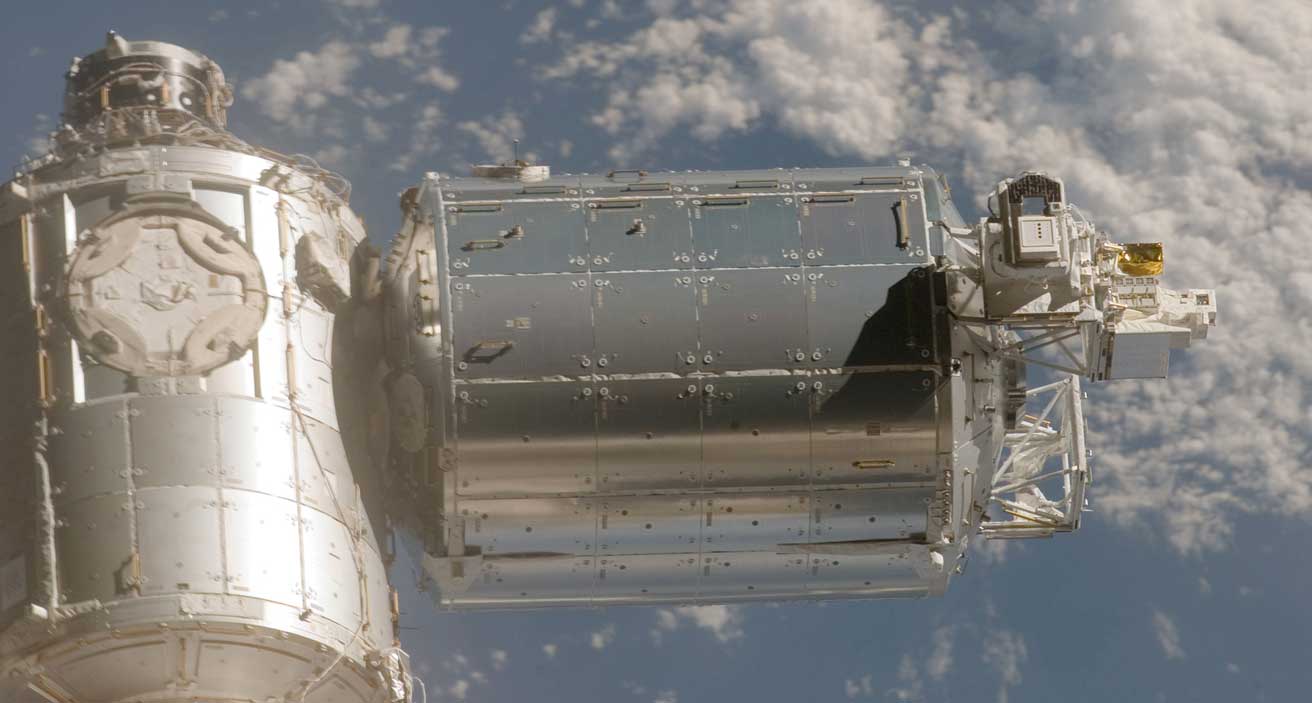
May 19.05.2011, XNUMX | A spectrometer that researchers at Fraunhofer Institute for Physical Measurement Technology (IPM) in Freiburg, measures solar activity on the International Space Station ISS with great precision and has already delivered unexpected results. In the future, these will be made publicly accessible in a database: climate researchers can use the data to investigate how much solar activity influences the Earth's climate.
So far, solar activity has fluctuated cyclically: Every eleven years It reached a minimum and every eleven years the sun shone with maximum intensity. However, with the last minimum in August 2008, the researchers needed patience: the activity of the celestial body did not increase as expected, but continued to decrease - completely unexpectedly, the sun broke out of its otherwise reliable rhythm. It was only a year later in September 2009 that their activity began to increase slightly again. To what extent do fluctuations in solar intensity and this shift in the solar cycle affect Earth's climate?
A sun spectrometer, developed by IPM from a single source, from electronics to optics to mechanics, helps to clarify this question. It also found the data showing the shift in the solar cycle. "We use the spectrometer to measure extreme ultraviolet radiation, or EUV for short, with wavelengths ranging from 17 to 220 nm," says Dr. med. Raimund Brunner, project manager at the IPM.
Much more precise measurements than before
The special The scientists can use the spectrometer to measure the sun's activity not only over a longer observation period than is usual with previous missions, but also much more precisely. This is made possible by two ionization chambers in the spectrometer that are filled with noble gas. When extreme UV radiation hits the noble gas, it releases electrons from the gas - an electric current flows.
This current is proportional to the intensity of solar radiation and serves as a basis for researchers to calibrate the spectrometer and make precise quantitative statements - and ultimately learn something about solar activity. “We achieve measured values with errors of less than ten percent, which is far better than previous results,” emphasizes Dr. Gerhard Schmidtke, scientific leader of the project.
 Layer thickness measurement ensures quality in powder coating
Layer thickness measurement ensures quality in powder coating
The results from this and two additional experiments on the space station should climate researchers will help in the future to find out to what extent fluctuations in solar intensity influence the climate of our atmosphere:
- How much of the greenhouse effect is homemade?
- How much of this is due to the change in solar radiation?
The measurement data reveals a lot about the conditions in the Ionosphere and thermosphere, which begin at an altitude of 80 km above the earth's surface. EUV radiation controls the temperature and particle densities of the ionosphere. This has consequences: If the intensity of the radiation changes, it affects both the orbit of satellites and the radio connection between the satellites and to the earth. For example, for GPS data to be accurate to the centimeter, the composition of the ionosphere must be known. In the future, the data obtained will be stored in a database on the Internet in order to make it publicly accessible.
Probably superimposition of solar cycles
Which is why the sun is out of its position for the first time since solar activity was documented eleven-year rhythm The researchers cannot yet say with certainty what happened. They suspect that in addition to the previously known solar cycle, there is another one, the Gleissberg cycle, which has a much longer period of time - probably 75 to 100 years - and is superimposed on the eleven-year cycle.
The mission time of the spectrometer labeled Solaces, which was initially only planned for one and a half years and is now three years, was recently extended by the ESA for a further three years. “This means we can also examine the maximum solar intensity in 2013,” says the scientist happily.
FAQ
What is a spectrometer?
A spectrometer is an essential instrument for Measuring the spectrum of light sources. It detects and analyzes light intensity across different portions of the electromagnetic spectrum, including visible light and other wavelength ranges.
What do you measure with a spectrometer?
Using a spectrometer, scientists and engineers can examine the spectral composition of light sources to identify chemical compositions, assess the quality of materials, or monitor environmental changes.
What kind of spectrometers are there?
There are different types of spectrometers, each specifically designed for different applications and measurement ranges of the spectrum. The most common include:
- Atomic absorption spectrometer specialized in the analysis of metals and other elements.
- Emission spectrometer measure the emission of light or electromagnetic radiation by a sample - Application: materials analysis and astronomy.
- Fluorescence spectrometer measure the emission of light given off by a substance when it absorbs light or other electromagnetic radiation.
- FTIR spectrometer (Fourier transform infrared) for the analysis of organic compounds and some inorganic substances. Each of these spectrometers uses different methods to obtain information about the composition and properties of samples.
- Infrared spectrometer measure the absorption, reflection or transmission of infrared light through a sample - Application: chemical analysis, food industry, environmental monitoring.
- mass spectrometry for analyzing the masses of molecules and atoms.
- Raman spectrometer use Raman scattering to obtain information about the molecular structure of a sample - Application: Materials science, forensics, pharmaceutical industry.
- spectrophotometer is mainly used to measure the absorption or reflection of light in different wavelength ranges.
- UV-Vis spectrometer measure the absorption or reflection of ultraviolet (UV) and visible (Vis) light by a sample - application: analytics, biochemistry, food industry.
How does an optical spectrometer work?
An optical spectrometer works, by passing light from a light source through a prism or grating, which breaks the light into its various spectral components (different colors or wavelengths). These components are then projected onto a detector that measures the light intensity in each section of the spectrum. The resulting data provides information about the spectral composition of the light source, enables the identification of chemical substances or the measurement of concentrations of certain elements or compounds in a sample.
Source: This article is based on information from the following companies: Bruker, Colorlite, Fraunhofer, Goehthe University, Polytec, Spectro.
You might also be interested in...

Infrared camera optimizes Laser Powder Bed Fusion 3D printing

Artificial Intelligence | trends and developments
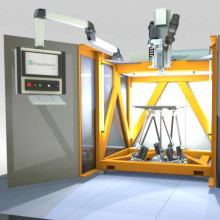
3D printer | Additive manufacturing of plastic parts
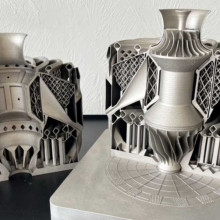
3D printer metal | Amazing Possibilities
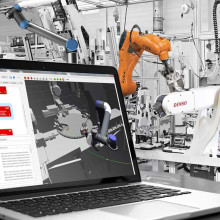
Programming Robots | software and controls
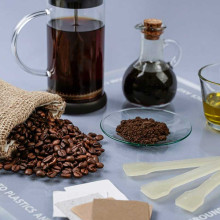
Plastics development: Bio-based, circular plastics for more sustainability
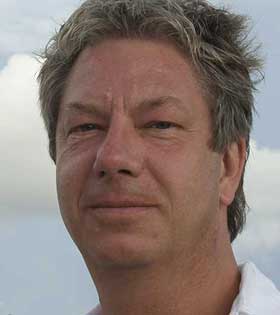
Jens Struck is a business owner, journalist and web designer at German Online Publisher GbR in Ried.
